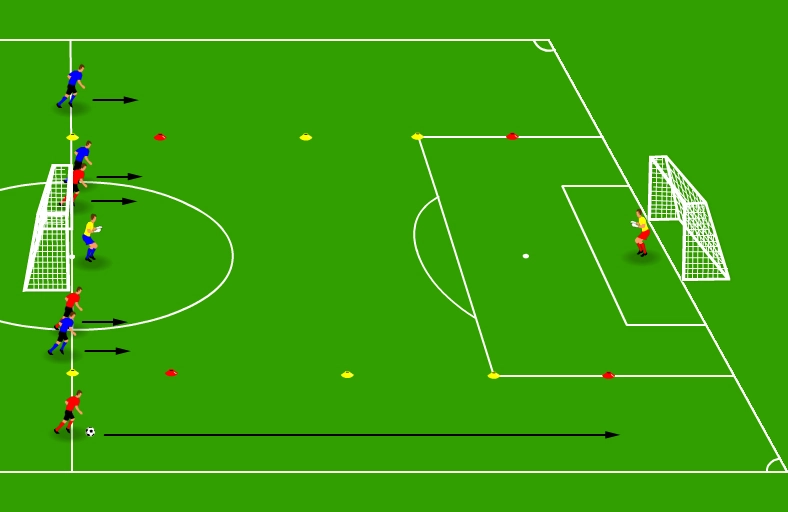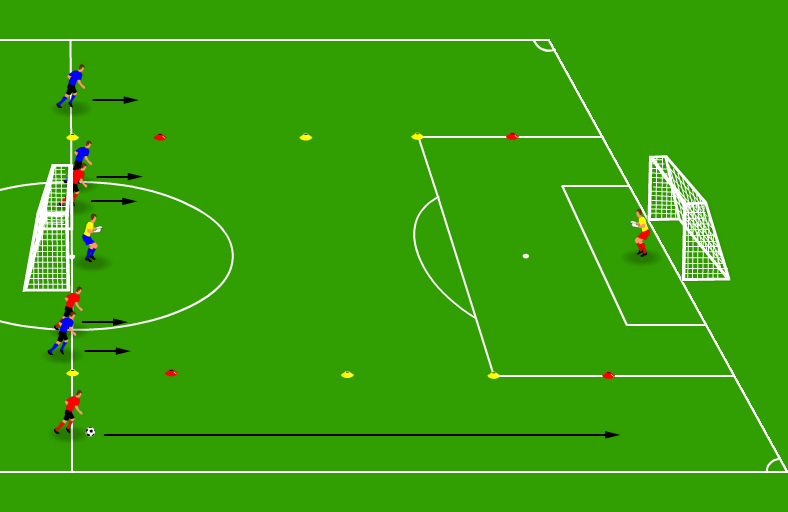Fast transition drill - Counterattacks from the wings

Transitioning from defence to attack must be done in seconds during all 90 minutes of a game. For example, the average EPL counterattack takes 15 seconds to complete, and Argentina took 14 seconds to score their second goal in the 2022 World Cup final. This post describes a fast transition drill that will get your players attacking and defending at full speed while building up your team’s conditioning.
Setup
This drill is a 4vs4 game with 3 field players and 1 goalkeeper per side. You will need half of a football pitch, a portable full-size goal to sit in the midfield, and cones to mark the wings as in the picture. If you have an entire field available and enough players, organise two groups running the same drill in parallel.
You will also need enough balls to keep the game running without wasting time and a clock to time the attacks. Ideally, get a portable clock with built-in horns.
This exercise is meant to be explosive and intense. So please don’t use it as the first drill of the training session, or players may get injured. Instead, use any of our warm-up drills to prepare players for this game. If you have players injured attending training to help, ask them to help time the attacks. Alternatively, each defending goalkeeper can start the clock to time the opposition’s attack.
Instructions
This drill is a 4 vs 4 game with full-size goals and a set time to complete each attack. In addition to official football rules, follow these instructions:
- All field players stay behind one of the goals to start. Four players will run the inside of the field. The remaining two players run on the wings.
- The drill starts with all field players running to one goal.
- The attacking team has 10-15 seconds to score. Adjust the time according to the fitness level of your team.
- The wing player always carries the ball. Players in the middle zone of the field can only defend or shoot.
- The wing player can only pass the ball after running past the second red cone.
- Crosses can be on the ground or through the air.
- When defenders recover the ball or time is up, they must pass it to their wing player and start the attack from behind the red cone.
- The clock restarts as soon as a defender controls the ball. A ball is considered controlled when a defender has stopped the ball and can comfortably pass the ball to the wing player.
- The defending player on the wing must run to the second cone and be ready to receive the ball from one of the defenders to avoid wasting time for his team.
- Sliding tackles are not allowed.
- If a defender kicks the ball out of the field, a ball is put in play immediately by the goalkeeper, an assistant, or a player not participating in the drill.
If nobody can assist with running the clock, ask each goalkeeper to take turns timing the attacks. So, each time a team attacks, the goalkeeper of the attacking team can control the time.
Run a set number of rounds, ideally 10 or more attacks. The team scoring more goals wins. You can repeat the drill to allow the wing players to switch to inside-players.
The animation below should clarify the instructions.

Takeaways
This drill focuses on speed and endurance. Additionality, your team will practice:
- Fitness. This game is physically demanding. Players must execute this drill fast and continuously.
- Speed and fast decision-making. Using a time limit forces players to attack and defend at speed.
- First touch. While there are no restrictions on the number of touches players can make, players must improve their first touch to control the ball and shoot quickly.
- Passing. Wingers must improve their passing technique to ensure the receiving player can easily control the ball.
- Teamwork. This drill encourages collaboration and synchronisation between players.
- Positioning. Players have to move on and off the ball to create passing lanes. Players must position themselves to close passing lanes and block shots when defending.
- Defending crosses. Defenders must be ready to close passing lanes or win the air game.
- Shooting accuracy. Practising with goalkeepers and defenders requires players to read their movements and shoot.
- Quick finishing. Attacking players must shoot as soon as they receive the ball to avoid running out of time.
- Goalkeeping at a short distance. This is a good drill for goalkeepers to practice saving shots from a short distance.
I hope you find this drill helpful. If you like this post, please share it with your friends. Also, if you know about other exercises or have questions, comment on our Facebook page.



